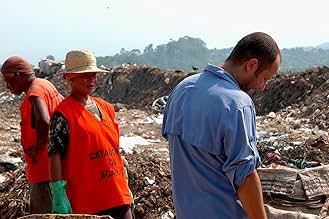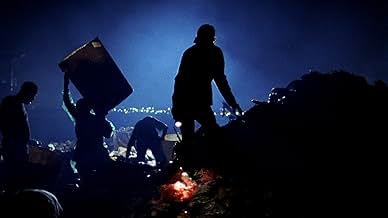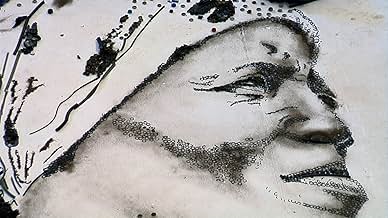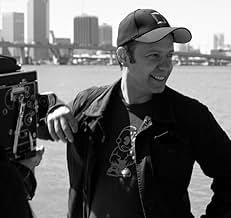On the outskirts of Rio de Janeiro is Jardim Gramacho, the world's largest landfill, where men and women sift through garbage for a living. Artist Vik Muniz produces portraits of the workers... Read allOn the outskirts of Rio de Janeiro is Jardim Gramacho, the world's largest landfill, where men and women sift through garbage for a living. Artist Vik Muniz produces portraits of the workers and learns about their lives.On the outskirts of Rio de Janeiro is Jardim Gramacho, the world's largest landfill, where men and women sift through garbage for a living. Artist Vik Muniz produces portraits of the workers and learns about their lives.
- Directors
- Star
- Nominated for 1 Oscar
- 29 wins & 13 nominations total
Featured reviews
This film has indeed reminded me that it is the one should have used the 4D gimmick which brazenly hyped by SPY KIDS: ALL THE TIME IN THE WORLD IN 4D (2011). With a bit odor touch, it could enhance more on the turmoil what we are watching in the landfill, and it is an extraordinary case that the sense of smell could actually have played a more essential role in the film genre.
Anyway, the environment-concerned stress has never been under the spotlight here, being a documentary about art and garbage pickers, one possible pitfall is the condescending inclination, but blithely it is not the case for this film, instead it spends most of time on the individual pickers who are involved in making this project, it captures many poignant moments behind their own stories. No doubt, Vik's work does have a pivotal role of altering the pickers lives, but the film does not overwhelmingly hinge on the process of making those artworks, and which perfectly encapsulates a more sublimated obligation in additional to a general aesthetic percipient, to change the world in a better way, and Vik and his team has done it, a tenacious and awe-inspiring job.
Apart from the riveting story, there are several panning scenes of the landfill are astonishing, our life is linking with garbages everyday, but most of us act like they are thoroughly vanishing from the earth after when they are being discarded in the dustbins. After watching this film, we might be coerced to face some soiled corner of our life which we are selectively and subjectively ignoring, and starts with the most basic one: behave yourself.
Vik and his friend Fábio spend two years in Jardim Gramacho and get closer to a group of pickers of recyclable materials and takes pictures of them. He uses his talent to make art using recyclable material and photographs the results. Then he travels to London and sells one of the portraits in an auction. With the money, the pickers buy a truck, equipment and build a leaning center and a library. The pickers that worked with him leans how to improve their lives and leave Jardim Gramacho.
"Waste Land" is a must see uplifting documentary that shows another side of Rio de Janeiro unusual in the cinema: the lives of people that earn their lives honestly working in the greatest landfill of the world and how they could improve their lives with social investment.
Vik Muniz gives a lesson to our corrupt politicians that embezzle money that are dedicated to people of the lower classes and shows how it is possible to improve lives using the money properly. His humanitarian work should be publicized worldwide and specially in my country. Maybe in the future, the president and politicians would be outraged not with handcuffed corrupts but with the damage that corruption causes to our people. My vote is nine.
Title (Brazil): "Lixo Extraordinário" ("Extraordinary Garbage")
Lower class lives are explored in a manner which not only illuminates the struggles that these individuals must go through, on a day to day basis, but also makes it clear that the cultural environment ; or landscape in Brazil, is changing.
Making a living is what they made until Muniz changed the way they looked a recyclables. He bonded the artifacts with the humans and created memorable portraits of the pickers. A show in London, which they attended, became a catalyst for change in their lives and in the lives of spectators who had no idea Rio's garbage had become Rio's recyclables under the hands of these professional pickers.
Muniz makes sure no one condescends, no one feels sorry for his subjects, some of whom have never known anything but the landfill and others who have chosen it rather than deal drugs or prostitute themselves. Waste Land is as dignified a story about the potential of the poor class to rise out of its garbage and transform it into art and a better life. For this reason, Muniz can stand with the great humanitarians like Albert Schwitzer and Mother Theresa.
Did you know
- TriviaThe Gramacho landfill was in fact deactivated in 2012. It is now a green area once again, wherein its native life has returned. However, many of the pickers forced into retirement were left without jobs and in poor quality of life.
- Quotes
Valter: [talking about the importance of recycling] People sometimes say "But one single can?" One single can is of great importance. Because 99 is not 100, and that single one will make the difference.
- ConnectionsFeatured in The 83rd Annual Academy Awards (2011)
- How long is Waste Land?Powered by Alexa
Details
- Release date
- Countries of origin
- Official sites
- Languages
- Also known as
- Wasteland
- Filming locations
- Jardim Gramacho, Rio de Janeiro, Brazil(landfill)
- Production companies
- See more company credits at IMDbPro
Box office
- Budget
- $1,500,000 (estimated)
- Gross US & Canada
- $187,716
- Opening weekend US & Canada
- $9,806
- Oct 31, 2010
- Gross worldwide
- $291,307
- Runtime1 hour 39 minutes
- Color
- Sound mix
- Aspect ratio
- 1.85 : 1
Contribute to this page























